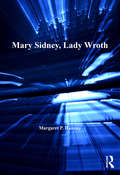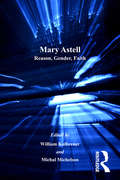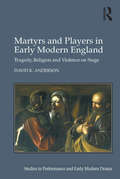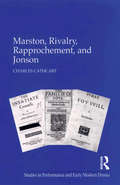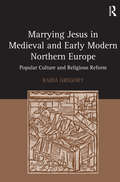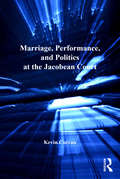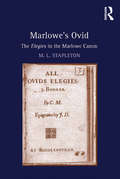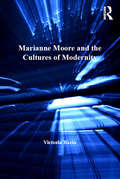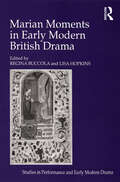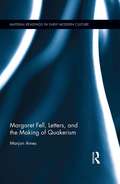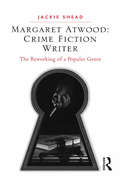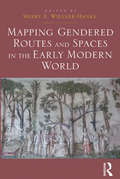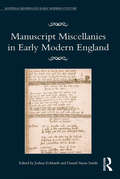- Table View
- List View
Mary Sidney, Lady Wroth
by Margaret P. HannayDespite her fascinating life and her importance as a writer, until now Lady Mary Wroth has never been the subject of a full-length biography. Margaret Hannay's reliance on primary sources results in some corrections, as well as additions, to our knowledge of Wroth's life, including Hannay's discovery of the career of her son William, the marriages of her daughter Katherine, her grandchildren, her last years, the date of her death, and the subsequent history of her manuscripts. This biography situates Lady Mary Wroth in her family and court context, emphasizing the growth of the writer's mind in the sections on her childhood and youth, with particular attention to her learned aunt, Mary Sidney Herbert, Countess of Pembroke, as literary mentor, and to her Continental connections, notably Louise de Coligny, Princess of Orange, and her stepson Prince Maurice. Subsequent chapters of the biography treat her experience at the court of Queen Anne, her relationships with parents and siblings, her love for her cousin William Herbert, her marriage to Robert Wroth, the birth and early death of her only legitimate child, her finances and properties, her natural children, her grandchildren, and her last years in the midst of England's civil wars. Throughout the biography attention is paid to the complex connections between Wroth's life and work. The narrative is enhanced with a chronology; family trees for the Sidneys and Wroths; a map of Essex, showing where Wroth lived; a chart of family alliances; portraits; and illustrations from her manuscripts.
Mary Astell: Reason, Gender, Faith
by William KolbrenerMary Astell: Reason, Gender, Faith includes essays from diverse disciplinary perspectives to consider the full range of Astell's political, theological, philosophical, and poetic writings. The volume does not eschew the more traditional scholarly interest in Astell's concerns about gender; rather, it reveals how Astell's works require attention not only for their role in the development of early modern feminism, but also for their interventions on subjects ranging from political authority to educational theory, from individual agency to divine service, and from Cartesian ethics to Lockean epistemology. Given the vast breadth of her writings, her active role within early modern political and theological debates, and the sophisticated complexity of her prose, Astell has few parallels among her contemporaries. Mary Astell: Reason, Gender, Faith bestows upon Astell the attention which she deserves not merely as a proto-feminist, but as a major figure of the early modern period.
Mary Astell: Reason, Gender, Faith
by William KolbrenerMary Astell: Reason, Gender, Faith includes essays from diverse disciplinary perspectives to consider the full range of Astell's political, theological, philosophical, and poetic writings. The volume does not eschew the more traditional scholarly interest in Astell's concerns about gender; rather, it reveals how Astell's works require attention not only for their role in the development of early modern feminism, but also for their interventions on subjects ranging from political authority to educational theory, from individual agency to divine service, and from Cartesian ethics to Lockean epistemology. Given the vast breadth of her writings, her active role within early modern political and theological debates, and the sophisticated complexity of her prose, Astell has few parallels among her contemporaries. Mary Astell: Reason, Gender, Faith bestows upon Astell the attention which she deserves not merely as a proto-feminist, but as a major figure of the early modern period.
Martyrs and Players in Early Modern England: Tragedy, Religion and Violence on Stage (Studies in Performance and Early Modern Drama)
by David K. AndersonFocusing on Christopher Marlowe, William Shakespeare, John Webster and John Milton, Martyrs and Players in Early Modern England argues that the English tragedians reflected an unease within the culture to acts of religious violence. David Anderson explores a link between the unstable emotional response of society to religious executions in the Tudor-Stuart period, and the revival of tragic drama as a major cultural form for the first time since classical antiquity. Placing John Foxe at the center of his historical argument, Anderson argues that Foxe’s Book of Martyrs exerted a profound effect on the social conscience of English Protestantism in his own time and for the next century. While scholars have in recent years discussed the impact of Foxe and the martyrs on the period’s literature, this book is the first to examine how these most vivid symbols of Reformation-era violence influenced the makers of tragedy. As the persecuting and the persecuted churches collided over the martyr’s body, Anderson posits, stress fractures ran through the culture and into the playhouse; in their depictions of violence, the early modern tragedians focused on the ethical confrontation between collective power and the individual sufferer. Martyrs and Players in Early Modern England sheds new light on the particular emotional energy of Tudor-Stuart tragedy, and helps explain why the genre reemerged at this time.
Martyrs and Players in Early Modern England: Tragedy, Religion and Violence on Stage (Studies in Performance and Early Modern Drama)
by David K. AndersonFocusing on Christopher Marlowe, William Shakespeare, John Webster and John Milton, Martyrs and Players in Early Modern England argues that the English tragedians reflected an unease within the culture to acts of religious violence. David Anderson explores a link between the unstable emotional response of society to religious executions in the Tudor-Stuart period, and the revival of tragic drama as a major cultural form for the first time since classical antiquity. Placing John Foxe at the center of his historical argument, Anderson argues that Foxe’s Book of Martyrs exerted a profound effect on the social conscience of English Protestantism in his own time and for the next century. While scholars have in recent years discussed the impact of Foxe and the martyrs on the period’s literature, this book is the first to examine how these most vivid symbols of Reformation-era violence influenced the makers of tragedy. As the persecuting and the persecuted churches collided over the martyr’s body, Anderson posits, stress fractures ran through the culture and into the playhouse; in their depictions of violence, the early modern tragedians focused on the ethical confrontation between collective power and the individual sufferer. Martyrs and Players in Early Modern England sheds new light on the particular emotional energy of Tudor-Stuart tragedy, and helps explain why the genre reemerged at this time.
Marston, Rivalry, Rapprochement, and Jonson (Studies in Performance and Early Modern Drama)
by Charles CathcartSignificant and unexplored signs of John Marston's literary rivalry with Ben Jonson are investigated here by Charles Cathcart. The centrepiece of the book is its argument that the anonymous play The Family of Love, sometimes attributed to Thomas Middleton and sometimes to Lording Barry, was in part the work of John Marston, and that it constitutes a whimsical statement of amity with Jonson. The book concerns itself with material rarely or never viewed as part of the "Poets' War" (such as the mutual attempted cuckoldings of The Insatiate Countess and the Middle Temple performance of Twelfth Night) rather than with texts (like Satiromastix and Poetaster) long considered in this light.
Marston, Rivalry, Rapprochement, and Jonson (Studies in Performance and Early Modern Drama)
by Charles CathcartSignificant and unexplored signs of John Marston's literary rivalry with Ben Jonson are investigated here by Charles Cathcart. The centrepiece of the book is its argument that the anonymous play The Family of Love, sometimes attributed to Thomas Middleton and sometimes to Lording Barry, was in part the work of John Marston, and that it constitutes a whimsical statement of amity with Jonson. The book concerns itself with material rarely or never viewed as part of the "Poets' War" (such as the mutual attempted cuckoldings of The Insatiate Countess and the Middle Temple performance of Twelfth Night) rather than with texts (like Satiromastix and Poetaster) long considered in this light.
Marrying Jesus in Medieval and Early Modern Northern Europe: Popular Culture and Religious Reform
by Rabia GregoryThe first full-length study of the notion of marriage to Jesus in late medieval and early modern popular culture, this book treats the transmission and transformation of ideas about this concept as a case study in the formation of religious belief and popular culture. Marrying Jesus in Medieval and Early Modern Northern Europe provides a history of the dispersion of theology about the bride of Christ in the period between the twelfth and seventeenth centuries and explains how this metaphor, initially devised for a religious elite, became integral to the laity's pursuit of salvation. Unlike recent publications on the bride of Christ, which explore the gendering of sanctity or the poetics of religious eroticism, this is a study of popular religion told through devotional media and other technologies of salvation. Marrying Jesus argues against the heteronormative interpretation that brides of Christ should be female by reconstructing the cultural production of brides of Christ in late medieval Europe. A central assertion of this book is that by the fourteenth century, worldly, sexually active brides of Christ, both male and female, were no longer aberrations. Analyzing understudied vernacular sources from the late medieval period - including sermons, early printed books, spiritual diaries, letters, songs, and hagiographies - Rabia Gregory shows how marrying Jesus was central to late medieval lay piety, and how the 'chaste' bride of Christ developed out of sixteenth-century religious disputes.
Marrying Jesus in Medieval and Early Modern Northern Europe: Popular Culture and Religious Reform
by Rabia GregoryThe first full-length study of the notion of marriage to Jesus in late medieval and early modern popular culture, this book treats the transmission and transformation of ideas about this concept as a case study in the formation of religious belief and popular culture. Marrying Jesus in Medieval and Early Modern Northern Europe provides a history of the dispersion of theology about the bride of Christ in the period between the twelfth and seventeenth centuries and explains how this metaphor, initially devised for a religious elite, became integral to the laity's pursuit of salvation. Unlike recent publications on the bride of Christ, which explore the gendering of sanctity or the poetics of religious eroticism, this is a study of popular religion told through devotional media and other technologies of salvation. Marrying Jesus argues against the heteronormative interpretation that brides of Christ should be female by reconstructing the cultural production of brides of Christ in late medieval Europe. A central assertion of this book is that by the fourteenth century, worldly, sexually active brides of Christ, both male and female, were no longer aberrations. Analyzing understudied vernacular sources from the late medieval period - including sermons, early printed books, spiritual diaries, letters, songs, and hagiographies - Rabia Gregory shows how marrying Jesus was central to late medieval lay piety, and how the 'chaste' bride of Christ developed out of sixteenth-century religious disputes.
Marriage, Performance, and Politics at the Jacobean Court
by Kevin CurranMarriage, Performance, and Politics at the Jacobean Court constitutes the first full-length study of Jacobean nuptial performance, a hitherto unexplored branch of early modern theater consisting of masques and entertainments performed for high-profile weddings. Scripted by such writers as Ben Jonson, Thomas Campion, George Chapman, and Francis Beaumont, these entertainments were mounted for some of the most significant political events of James's English reign. Here Kevin Curran analyzes all six of the elite weddings celebrated at the Jacobean court, reading the masques and entertainments that headlined these events alongside contemporaneously produced panegyrics, festival books, sermons, parliamentary speeches, and other sources. The study shows how, collectively, wedding entertainments turned the idea of union into a politically versatile category of national representation and offered new ways of imagining a specifically Jacobean form of national identity by doing so.
Marriage, Performance, and Politics at the Jacobean Court
by Kevin CurranMarriage, Performance, and Politics at the Jacobean Court constitutes the first full-length study of Jacobean nuptial performance, a hitherto unexplored branch of early modern theater consisting of masques and entertainments performed for high-profile weddings. Scripted by such writers as Ben Jonson, Thomas Campion, George Chapman, and Francis Beaumont, these entertainments were mounted for some of the most significant political events of James's English reign. Here Kevin Curran analyzes all six of the elite weddings celebrated at the Jacobean court, reading the masques and entertainments that headlined these events alongside contemporaneously produced panegyrics, festival books, sermons, parliamentary speeches, and other sources. The study shows how, collectively, wedding entertainments turned the idea of union into a politically versatile category of national representation and offered new ways of imagining a specifically Jacobean form of national identity by doing so.
Marlowe's Ovid: The Elegies in the Marlowe Canon
by M. L. StapletonThe first book of its kind, Marlowe's Ovid explores and analyzes in depth the relationship between the Elegies-Marlowe's translation of Ovid's Amores-and Marlowe's own dramatic and poetic works. Stapleton carefully considers Marlowe's Elegies in the context of his seven known dramatic works and his epyllion, Hero and Leander, and offers a different way to read Marlowe. Stapleton employs Marlowe's rendition of the Amores as a way to read his seven dramatic productions and his narrative poetry while engaging with previous scholarship devoted to the accuracy of the translation and to bibliographical issues. The author focuses on four main principles: the intertextual relationship of the Elegies to the rest of the author's canon; its reflection of the influence of Erasmian humanist pedagogy, imitatio and aemulatio; its status as the standard English Amores until the Glorious Revolution, part of the larger phenomenon of pan-European Renaissance Ovidianism; its participation in the genre of the sonnet sequence. He explores how translating the Amores into the Elegies profited Marlowe as a writer, a kind of literary archaeology that explains why he may have commenced such an undertaking. Marlowe's Ovid adds to the body of scholarly work in a number of subfields, including classical influences in English literature, translation, sexuality in literature, early modern poetry and drama, and Marlowe and his milieu.
Marlowe's Ovid: The Elegies in the Marlowe Canon
by M. L. StapletonThe first book of its kind, Marlowe's Ovid explores and analyzes in depth the relationship between the Elegies-Marlowe's translation of Ovid's Amores-and Marlowe's own dramatic and poetic works. Stapleton carefully considers Marlowe's Elegies in the context of his seven known dramatic works and his epyllion, Hero and Leander, and offers a different way to read Marlowe. Stapleton employs Marlowe's rendition of the Amores as a way to read his seven dramatic productions and his narrative poetry while engaging with previous scholarship devoted to the accuracy of the translation and to bibliographical issues. The author focuses on four main principles: the intertextual relationship of the Elegies to the rest of the author's canon; its reflection of the influence of Erasmian humanist pedagogy, imitatio and aemulatio; its status as the standard English Amores until the Glorious Revolution, part of the larger phenomenon of pan-European Renaissance Ovidianism; its participation in the genre of the sonnet sequence. He explores how translating the Amores into the Elegies profited Marlowe as a writer, a kind of literary archaeology that explains why he may have commenced such an undertaking. Marlowe's Ovid adds to the body of scholarly work in a number of subfields, including classical influences in English literature, translation, sexuality in literature, early modern poetry and drama, and Marlowe and his milieu.
Marianne Moore and the Cultures of Modernity
by Victoria BazinVictoria Bazin examines the poetry of Marianne Moore as it is shaped by and responsive to the experience of being a modern woman, of living in the aftermath of the First World War, of being interpellated as a modern consumer and of writing in "the age of mechanical reproduction." She argues that Moore's textual collages and syllabic sculptures are based on the cultural clutter or debris of modernity, on textual extracts and reproductions, on the phantasmagoria of city life revealing something modernism worked hard to conceal: its relation to modernity, more specifically its relation to the new emerging and expanding mass consumer culture. Drawing extensively on archival resources to trace Moore's influences and to describe her own distinctive modernist aesthetic, this book argues that it was her feminist adaptation of pragmatism that shaped her poetic response to modernity. Moore's use of the quoted fragment is conceptualised in relation not only to Walter Benjamin's philosophical history but also to William James's image of the world as a series of "partial stories." As such, this account of Marianne Moore not only contributes to a greater understanding of the poet and her work, but it also offers up a more politicized and historically nuanced understanding of poetic modernism between the wars, one that retains a sense of the formal complexities of poetic language and the poet's own ethical imperatives whilst also recognising the material impact of modernity upon the modernist poem. This book will appeal, therefore, not only to scholars already familiar with Moore's poetry but more widely to those interested in modernism and American culture between the wars.
Marianne Moore and the Cultures of Modernity
by Victoria BazinVictoria Bazin examines the poetry of Marianne Moore as it is shaped by and responsive to the experience of being a modern woman, of living in the aftermath of the First World War, of being interpellated as a modern consumer and of writing in "the age of mechanical reproduction." She argues that Moore's textual collages and syllabic sculptures are based on the cultural clutter or debris of modernity, on textual extracts and reproductions, on the phantasmagoria of city life revealing something modernism worked hard to conceal: its relation to modernity, more specifically its relation to the new emerging and expanding mass consumer culture. Drawing extensively on archival resources to trace Moore's influences and to describe her own distinctive modernist aesthetic, this book argues that it was her feminist adaptation of pragmatism that shaped her poetic response to modernity. Moore's use of the quoted fragment is conceptualised in relation not only to Walter Benjamin's philosophical history but also to William James's image of the world as a series of "partial stories." As such, this account of Marianne Moore not only contributes to a greater understanding of the poet and her work, but it also offers up a more politicized and historically nuanced understanding of poetic modernism between the wars, one that retains a sense of the formal complexities of poetic language and the poet's own ethical imperatives whilst also recognising the material impact of modernity upon the modernist poem. This book will appeal, therefore, not only to scholars already familiar with Moore's poetry but more widely to those interested in modernism and American culture between the wars.
Marian Moments in Early Modern British Drama
by Lisa HopkinsConcerning itself with the complex interplay between iconoclasm against images of the Virgin Mary in post-Reformation England and stage representations that evoke various 'Marian moments' from the medieval, Catholic past, this collection answers the call for further investigation of the complex relationship between the fraught religio-political culture of the early modern period and the theater that it spawned. Joining historians in rejecting the received belief that Catholicism could be turned on and off like a water spigot in response to sixteenth-century religious reform, the early modern British theater scholars in this collection turn their attention to the vestiges of Catholic tradition and culture that leak out in stage imagery, plot devices, and characterization in ways that are not always clearly engaged in the business of Protestant panegyric or polemic. Among the questions they address are: What is the cultural function of dramatic Marian moments? Are Marian moments nostalgic for, or critical of, the 'Old Faith'? How do Marian moments negotiate the cultural trauma of iconoclasm and/or the Reformation in early modern England? Did these stage pictures of Mary provide subversive touchstones for the Old Faith of particular import to crypto-Catholic or recusant members of the audience?
Marian Moments in Early Modern British Drama
by Lisa HopkinsConcerning itself with the complex interplay between iconoclasm against images of the Virgin Mary in post-Reformation England and stage representations that evoke various 'Marian moments' from the medieval, Catholic past, this collection answers the call for further investigation of the complex relationship between the fraught religio-political culture of the early modern period and the theater that it spawned. Joining historians in rejecting the received belief that Catholicism could be turned on and off like a water spigot in response to sixteenth-century religious reform, the early modern British theater scholars in this collection turn their attention to the vestiges of Catholic tradition and culture that leak out in stage imagery, plot devices, and characterization in ways that are not always clearly engaged in the business of Protestant panegyric or polemic. Among the questions they address are: What is the cultural function of dramatic Marian moments? Are Marian moments nostalgic for, or critical of, the 'Old Faith'? How do Marian moments negotiate the cultural trauma of iconoclasm and/or the Reformation in early modern England? Did these stage pictures of Mary provide subversive touchstones for the Old Faith of particular import to crypto-Catholic or recusant members of the audience?
Margaret Fell, Letters, and the Making of Quakerism (Material Readings in Early Modern Culture)
by Marjon AmesIntensely persecuted during the English Interregnum, early Quakers left a detailed record of the suffering they endured for their faith. Margaret Fell, Letters, and the Making of Quakerism is the first book to connect the suffering experience with the communication network that drew the faithful together to create a new religious community. This study explores the ways in which early Quaker leaders, particularly Margaret Fell, helped shape a stable organization that allowed for the transition from movement to church to occur. Fell’s role was essential to this process because she developed and maintained the epistolary exchange that was the basis of the early religious community. Her efforts allowed for others to travel and spread the faith while she served as nucleus of the community’s communication network by determining how and where to share news. Memory of the early years of Quakerism were based on the letters Fell preserved. Marjon Ames analyzes not only how Fell’s efforts shaped the inchoate faith, but also how subsequent generations memorialized their founding members.
Margaret Fell, Letters, and the Making of Quakerism (Material Readings in Early Modern Culture)
by Marjon AmesIntensely persecuted during the English Interregnum, early Quakers left a detailed record of the suffering they endured for their faith. Margaret Fell, Letters, and the Making of Quakerism is the first book to connect the suffering experience with the communication network that drew the faithful together to create a new religious community. This study explores the ways in which early Quaker leaders, particularly Margaret Fell, helped shape a stable organization that allowed for the transition from movement to church to occur. Fell’s role was essential to this process because she developed and maintained the epistolary exchange that was the basis of the early religious community. Her efforts allowed for others to travel and spread the faith while she served as nucleus of the community’s communication network by determining how and where to share news. Memory of the early years of Quakerism were based on the letters Fell preserved. Marjon Ames analyzes not only how Fell’s efforts shaped the inchoate faith, but also how subsequent generations memorialized their founding members.
Margaret Atwood: The Reworking of a Popular Genre
by Jackie SheadExploring how Margaret Atwood’s fiction reimagines the figure of the detective and the nature of crime, Jackie Shead shows how the author radically reworks the crime fiction genre. Shead focuses on Surfacing, Bodily Harm, Alias Grace, The Blind Assassin, Oryx and Crake and selected short fiction, showing the ways in which Atwood’s protagonists are confronted by their own collusion in hegemonic assumptions and thus are motivated to investigate and expose crimes of gender, class and colonialism. Shead begins with a discussion of how Atwood’s treatment of crime fiction’s generic elements, particularly those of the whodunit, clue puzzle and spy thriller, departs from convention. Through discussion of Atwood’s metafictive strategies, Shead also examines Atwood’s techniques for activating her readers as investigators who are offered an educative process parallel to that experienced by some of the author’s protagonists. This book also marks a significant intervention in an ongoing debate among Atwood critics that pits the author’s postmodernism against her ethical and humanistic concerns.
Margaret Atwood: The Reworking of a Popular Genre
by Jackie SheadExploring how Margaret Atwood’s fiction reimagines the figure of the detective and the nature of crime, Jackie Shead shows how the author radically reworks the crime fiction genre. Shead focuses on Surfacing, Bodily Harm, Alias Grace, The Blind Assassin, Oryx and Crake and selected short fiction, showing the ways in which Atwood’s protagonists are confronted by their own collusion in hegemonic assumptions and thus are motivated to investigate and expose crimes of gender, class and colonialism. Shead begins with a discussion of how Atwood’s treatment of crime fiction’s generic elements, particularly those of the whodunit, clue puzzle and spy thriller, departs from convention. Through discussion of Atwood’s metafictive strategies, Shead also examines Atwood’s techniques for activating her readers as investigators who are offered an educative process parallel to that experienced by some of the author’s protagonists. This book also marks a significant intervention in an ongoing debate among Atwood critics that pits the author’s postmodernism against her ethical and humanistic concerns.
Mapping Gendered Routes and Spaces in the Early Modern World
by Merry E. Wiesner-HanksHow did gender figure in understandings of spatial realms, from the inner spaces of the body to the furthest reaches of the globe? How did women situate themselves in the early modern world, and how did they move through it, in both real and imaginary locations? How do new disciplinary and geographic connections shape the ways we think about the early modern world, and the role of women and men in it? These are the questions that guide this volume, which includes articles by a select group of scholars from many disciplines: Art History, Comparative Literature, English, German, History, Landscape Architecture, Music, and Women's Studies. Each essay reaches across fields, and several are written by interdisciplinary groups of authors. The essays also focus on many different places, including Rome, Amsterdam, London, and Paris, and on texts and images that crossed the Atlantic and the Mediterranean, or that portrayed real and imagined people who did. Many essays investigate topics key to the ’spatial turn’ in various disciplines, such as borders and their permeability, actual and metaphorical spatial crossings, travel and displacement, and the built environment.
Mapping Gendered Routes and Spaces in the Early Modern World
by Merry E. Wiesner-Hanks Merry E. Wiesner-HanksHow did gender figure in understandings of spatial realms, from the inner spaces of the body to the furthest reaches of the globe? How did women situate themselves in the early modern world, and how did they move through it, in both real and imaginary locations? How do new disciplinary and geographic connections shape the ways we think about the early modern world, and the role of women and men in it? These are the questions that guide this volume, which includes articles by a select group of scholars from many disciplines: Art History, Comparative Literature, English, German, History, Landscape Architecture, Music, and Women's Studies. Each essay reaches across fields, and several are written by interdisciplinary groups of authors. The essays also focus on many different places, including Rome, Amsterdam, London, and Paris, and on texts and images that crossed the Atlantic and the Mediterranean, or that portrayed real and imagined people who did. Many essays investigate topics key to the ’spatial turn’ in various disciplines, such as borders and their permeability, actual and metaphorical spatial crossings, travel and displacement, and the built environment.
Manuscript Miscellanies in Early Modern England (Material Readings in Early Modern Culture)
by Joshua Eckhardt Daniel Starza SmithPerhaps more than any other kind of book, manuscript miscellanies require a complex and ’material’ reading strategy. This collection of essays engages the renewed and expanding interest in early modern English miscellanies, anthologies, and other compilations. Manuscript Miscellanies in Early Modern England models and refines the study of these complicated collections. Several of its contributors question and redefine the terms we use to describe miscellanies and anthologies. Two senior scholars correct the misidentification of a scribe and, in so doing, uncover evidence of a Catholic, probably Jesuit, priest and community in a trio of manuscripts. Additional contributors show compilers interpreting, attributing, and arranging texts, as well as passively accepting others’ editorial decisions. While manuscript verse miscellanies remain appropriately central to the collection, several essays also involve print and prose, ranging from letters to sermons and even political prophesies. Using extensive textual and bibliographical evidence, the collection offers stimulating new readings of literature, politics, and religion in the early modern period, and promises to make important interventions in academic studies of the history of the book.
Manuscript Miscellanies in Early Modern England (Material Readings in Early Modern Culture)
by Joshua Eckhardt Daniel Starza SmithPerhaps more than any other kind of book, manuscript miscellanies require a complex and ’material’ reading strategy. This collection of essays engages the renewed and expanding interest in early modern English miscellanies, anthologies, and other compilations. Manuscript Miscellanies in Early Modern England models and refines the study of these complicated collections. Several of its contributors question and redefine the terms we use to describe miscellanies and anthologies. Two senior scholars correct the misidentification of a scribe and, in so doing, uncover evidence of a Catholic, probably Jesuit, priest and community in a trio of manuscripts. Additional contributors show compilers interpreting, attributing, and arranging texts, as well as passively accepting others’ editorial decisions. While manuscript verse miscellanies remain appropriately central to the collection, several essays also involve print and prose, ranging from letters to sermons and even political prophesies. Using extensive textual and bibliographical evidence, the collection offers stimulating new readings of literature, politics, and religion in the early modern period, and promises to make important interventions in academic studies of the history of the book.
